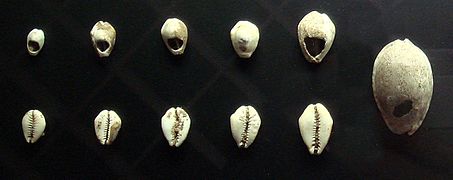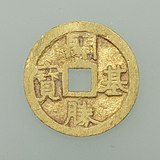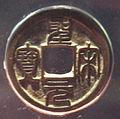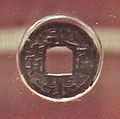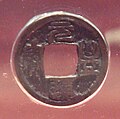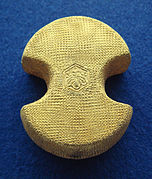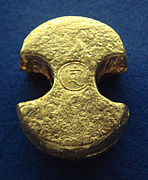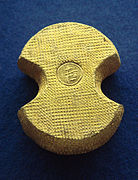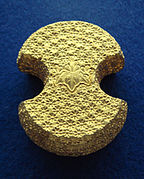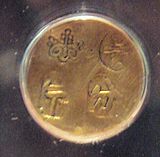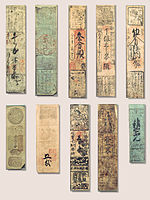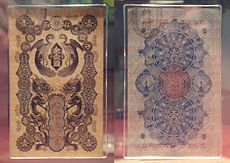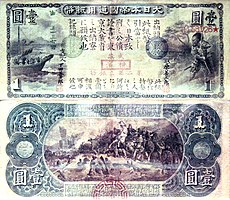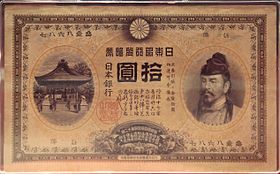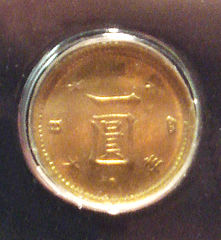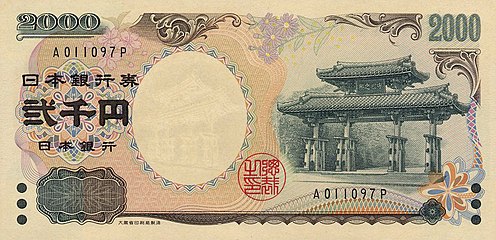Japanese currency

Japanese currencyhas a history covering the period from the 8th century CE to the present. After the traditional usage ofriceas acurrency medium,Japan adoptedcurrency systems and designs from Chinabefore developing a separate system of its own.
History
[edit]Commodity money
[edit]

Before the 7th-8th centuries CE, Japan usedcommodity moneyfor trading. This generally consisted of material that was compact and easily transportable and had a widely recognized value. Commodity money was a great improvement over simplebarter,in which commodities were simply exchanged against others. Ideally, commodity money had to be widely accepted, easily portable and storable, and easily combined and divided in order to correspond to different values. The main items of commodity money in Japan werearrowheads,ricegrains andgoldpowder.
This contrasted somewhat with countries likeChina,where one of the most important items of commodity money came from the southern seas:shells.[1]Since then however, the shell has become a symbol for money in many Chinese and Japaneseideograms.[1]
Early coinage
[edit]
The earliest coins to reach Japan were ChineseBan Liangand Wu Zhu coins, as well asthe coins produced by Wang Mangduring the first centuries of the first millennium CE; these coins have been excavated all over Japan, but as Japan's economy was not sufficiently developed at the time, these coins were more likely to be used as precious objects rather than a means of exchange; rice and cloth served as the main currencies of Japan at the time.[2]
The first coins produced in Japan are called theMumonginsen( vô văn ngân 銭, or 'silver coins without inscription') and the copper alloyFuhonsen( phú bổn 銭, coins made from an alloy of copper, lead and tin) which were all introduced in the late seventh century. These currencies (alongside other reforms) were based on the Chinese system and were therefore based on theChinese units of measurement.In modern times the usage ofFuhonsenhas often been interpreted as charms rather than currency, but it has recently been discovered that these copper coins were in fact the first government-made coinage of Japan.[2]
Kōchōsen currency system (8th–10th centuries)
[edit]Embassy to the Tang court (630 CE)
[edit]Japan's first formal currency system was theKōchōsen(Japanese: Hoàng triều 銭, "Imperial currency" ). It was exemplified by the adoption of Japan's first official coin type, theWadōkaichin.[3]It was first minted in 708 CE on the orders ofEmpress Genmei,Japan's 43rd Imperial ruler.[3]"Wadō Kaichin"is the reading of the four characters printed on the coin, and is thought to be composed of the era nameWadō( hòa đồng, "Japanese copper" ), which could alternatively mean "happiness", and "Kaichin", thought to be related to "currency".[1]
This coinage was inspired by the Tang coinage ( đường 銭) namedKaigen Tsūhō(Chinese: Khai nguyên thông bảo,Kai Yuan Tong Bao), first minted inChang'anin 621 CE.[1]The Wadokaichin had the same specifications as the Chinese coin, with a diameter of 2.4 cm and a weight of 3.75g.[1]
-
Chinese shell money was widely accepted, easy to carry, and easy to count.
-
Japanese commodity money before the 8th century, including arrowheads, rice grains, and gold powder. Now in the Japanese Currency Museum.
-
The Japanese embassy to the Tang court.
-
The Nihon Shoki entry of 15 April 683 (Tenmu 12th year) mandates the use of copper coins.
-
Known coin types of Japan from 708 to 958, chronologically arranged.
Japan's contacts with the Chinese mainland became intense during theTang period,with many exchanges and cultural imports occurring.[3]The first Japanese embassy to China is recorded to have been sent in 630.[1]The importance of metallic currency appeared to Japanese nobles, probably leading to some coin minting at the end of the 7th century,[3]such as theFuhonsencoinage ( phú bổn 銭), discovered in 1998 through archaeological research inNara Prefecture.[1]An entry of theNihon Shokidated April 15, 683 mentions: "From now on, copper coins should be used, but silver coins should not be used", which is thought to order the adoption of theFuhonsencopper coins.[1]The first official coinage was struck in 708.
Currency reform (760)
[edit]| Part ofa serieson |
| Numismatics the study of currency |
|---|
 |
TheWadōkaichinsoon became debased, as the government rapidly issued coins with progressively lesser metallic content, and local imitations thrived.[1]In 760, a reform was put in place, in which a new copper coin calledMan'nen Tsūhō( vạn niên thông bảo ) was worth 10 times the value of the formerWadōkaichin,with also a new silver coin namedTaihei Genpō( đại bình nguyên bảo ) with a value of 10 copper coins, as well as a new gold coin namedKaiki Shoho( khai cơ thắng bảo ) with a value of 10 silver coins.[1]
Silver minting was soon abandoned however, but copper minting took place throughout theNara period.[3]A variety of coin types are known, altogether 12 types, including one coin type in gold.[1]
-
Japanese gold coin Kaiki Shōhō ( khai cơ thắng bảo ) from 760.
-
A Silver Wadō Kaichin ( hòa đồng khai trân ) coin from 8th-century Japan.
Last issues (958)
[edit]TheKōchōsenJapanese system of coinage became strongly debased, with its metallic content and value decreasing. By the middle of the 9th century, the value of a coin in rice had fallen to 1/150th of its value of the early 8th century.
By the end of the 10th century, compounded with weaknesses in the political system, this led to the abandonment of the national currency, with the return toriceas a currency medium.[1]The last official Japanese coin issue was in 958, with very low quality coins calledKengen Taihō( càn nguyên đại bảo ), which soon fell into disuse.[1]
The lastKōchōsencoins produced after the Wadōkaichin include:[2]
| Inscription | Kyūjitai | Shinjitai | Year of introduction (Julian calendar) |
Image |
|---|---|---|---|---|
| Wadō Kaichin | Hòa đồng khai trân | Hòa đồng khai trân | 708 | 
|
| Man'nen Tsūhō | Vạn niên thông bảo | Vạn niên thông bảo | 760 | 
|
| Jingū Kaihō | Thần công khai bảo | Thần công khai bảo | 765 | 
|
| Ryūhei Eihō | Long bình vĩnh bảo | Long bình vĩnh bảo | 796 | 
|
| Fuju Shinpō | Phú thọ thần bảo | Phú thọ thần bảo | 818 | 
|
| Jōwa Shōhō | Thừa hòa xương bảo | Thừa hòa xương bảo | 835 | 
|
| Chōnen Taihō | Trường niên đại bảo | Trường niên đại bảo | 848 | 
|
| Jōeki Shinpō | Nhiêu ích thần bảo | Nhiêu ích thần bảo | 859 | 
|
| Jōgan Eihō | Trinh quan vĩnh bảo | Trinh quan vĩnh bảo | 870 | 
|
| Kanpyō Taihō | Khoan bình đại bảo | Khoan bình đại bảo | 890 | 
|
| Engi Tsūhō | Diên hỉ thông bảo | Diên hỉ thông bảo | 907 | 
|
| Kengen Taihō | Càn nguyên đại bảo | Càn nguyên đại bảo | 958 | 
|
Chinese coinage (12th–17th centuries)
[edit]Importation of Chinese coinage
[edit]From the 12th century, the expansion of trade and barter again highlighted the need for a currency. Chinese coinage came to be used as the standard currency of Japan, for a period lasting from the 12th to the 17th century.[1]Coins were obtained from China through trade or through"Wakō"piracy.[1]Coins were also imported fromAnnam(modernVietnam) andKorea.[1]
There is evidence to suggest that theYuan dynastyused to extensively exportChinese cash coinsto Japan for local circulation. TheSinan shipwreck,which was a ship from Ningbo to Hakata that sank off the Korean coast in the year 1323,[4]carried some 8,000strings of cash coins,[5]which weighed about 26,775 kg.[6]
Imitations of Chinese coinage
[edit]As the Chinese coins were not in sufficient number as trade and economy expanded, local Japanese imitations of Chinese coins were made from the 14th century, especially imitations ofMingcoins, with inscribed names identical to those of contemporary Chinese coins.[1]These coins had a very low value compared to Chinese coins, and several of them had to be exchanged for just one Chinese coin. This situation continued until the beginning of theEdo period,when a new system was put in place.
-
Northern SongChinese coinShèngsòng Yuánbǎo( thánh tống nguyên bảo ).
-
Seisō Genbō( thánh tống nguyên bảo ) Japanese imitation of the Song type, 14th–17th centuries.
-
ChineseMingcoinYǒnglè Tōngbǎo( vĩnh nhạc thông bảo ) used as currency in Japan.
-
Eiraku Tsūhō( vĩnh lặc thông bảo ) Japanese imitation of the Ming type, 14th–17th centuries.
-
Genpō Tsūhō( nguyên phong thông bảo ) Japanese imitation, 14th–17th centuries.

Local experiments (16th century)
[edit]The growth of the economy and trade meant that small copper currency became insufficient to cover the amounts that were being exchanged. During theSengoku period,the characteristics of the future Edo Period system began to emerge. Local Lords developed trade, abolishing monopolistic guilds, which led to the need for large-denomination currencies. From the 16th century, local experiments started to be made, with the minting of local coins, sometimes in gold. Especially theTakeda clanofKōshūminted gold coins which were later adopted by theTokugawa shogunate.[1]
Hideyoshiunified Japan, and thus centralized most of the minting of large denomination silver and gold coins, effectively putting in place the basis of a unified currency system. Hideyoshi developed the largeŌbanplate, also called theTenshōŌban ( thiên chính đại phán ), in 1588, a predecessor to Tokugawa gold coinage.[7]
A common practice in that period was to melt gold into copper molds for convenience, derived from thesyceemanufacturing method. These were called Bundōkin ( phân đồng kim ), of which there were two types, the small Kobundō ( tiểu phân đồng ), and the large Ōbundō ( đại phân đồng ). A Kobundō would represent about 373 g in gold.[1]
-
Kiritomoeban ( đồng ba phán ), 16th century.
-
Kobundō, "Turtle scalePaulownia"Kinkōkirimark ( quy giáp đồng ),Nunome( bố mục ) emblem.
-
Kobundō, "Fixed"Teimark ( định ),Ishime( thạch mục ) emblem.
-
Kobundō, "happiness"Kichimark ( cát ) mark,Nunome( bố mục ) emblem.
-
A Kobundō ( tiểu phân đồng ), 95–97% gold, "Paulownia"Kirimark ( đồng ), Kikubana ( cúc hoa ) emblem, 373.11 grams, Japan.
-
An early minting experiment by the Takeda clan of Kōshū ( giáp châu kim ) in the 16th century.
Tokugawa currency (17th–19th centuries)
[edit]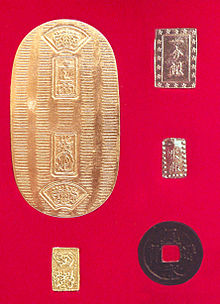
Tokugawa coinagewas a unitary and independent metallic monetary system established byshōgunTokugawa Ieyasuin 1601 inJapan,and which lasted throughout theTokugawa perioduntil its end in 1867.[8]
From 1601, Tokugawa coinage consisted of gold, silver, and bronze denominations.[8]The denominations were fixed, but the rates actually fluctuated on the exchange market.[8]Tokugawa started by minting Keicho gold and silver coins, and Chinese copper coins were later replaced by Kan'ei Tsuho coins in 1670.
The material for the coinage came from gold and silver mines across Japan. For this purpose, new gold mines were opened, such as theSadoandToi gold minesin theIzu Peninsula.Regarding diamond[clarification needed]coins, theKan'ei Tsūhōcoin ( khoan vĩnh thông bảo ) came to replace the Chinese coins that had been in circulation in Japan, as well as those that were privately minted, and became the legal tender for small denominations.[1]
Yamada Hagaki,Japan's first notes, were issued around 1600 byShintopriests also working as merchants in theIse-Yamada (modernMie Prefecture), in exchange for silver.[1]This was earlier than the firstgoldsmithnotes issued inEnglandaround 1640.[1]The first known feudal note was issued by the Fukui clan in 1661. During the 17th century, the feudal domains developed a system offeudal notes,giving currency to pledged notes issued by the lord of the domain, in exchange for convertibility to gold, silver or copper.[1]Japan thus combined gold, silver, and copper standards with the circulation ofpaper money.[1]
Tokugawa coinage remained in use during theSakokuperiod of seclusion, although it was progressively debased to try to manage government deficits. The first debasement, in 1695, was called the Genroku Recoinage.[1]
-
Feudal notes of Japan,Edo period.
Bakumatsu currency (1854–1868)
[edit]
The Tokugawa coinage collapsed following the reopening of Japan to the West in 1854, as the silver-gold exchange rates gave foreigners huge opportunities forarbitrage,leading to the export of large quantities of gold. Gold traded for silver in Japan at a 1:5 ratio, while that ratio was 1:15 abroad. During theBakumatsuperiod in 1859Mexican dollarswere even given official currency in Japan, by coining them with marks in Japanese and officializing their exchange rate of three"Bu"[clarification needed].They were calledAratame Sanbu Sadame( cải tam phân định, "Fixed to the value of threebu").[1]
Meanwhile, local governments issued their own currency chaotically, so that the nation's money supply expanded by 2.5 times between 1859 and 1869, leading to crumbling money values and soaring prices. The system was replaced by a new one after the conclusion of theBoshin War,and with the onset of theMeiji governmentin 1868.[1]
-
A Mexican dollar used as currency in Japan, marked with "Aratame sanbu sadame" (Fixed to the value of three bu) ( cải tam phân định ) from 1859.
-
Allegory of inflation and soaring prices during the Bakumatsu era.
Imperial Japan (1871–present)
[edit]Following 1868, a new currency system based on theJapanese yenwas progressively established along Western lines, which has remained Japan's currency system to this day.
Immediately after theMeiji Restorationin 1868, previous gold, silver and copper coins, as well as feudal notes, continued to circulate, leading to great confusion. In 1868, the government also issued coins and gold-convertible paper money, calledDaijōkansatsu( thái chính quan trát ), denominated inRyō,an old unit from the Edo period, and private banks calledKawase Kaishawere allowed to issue their own currency as well. Complexity, widespread counterfeiting of gold coins and feudal notes led to widespread confusion.[1]
Birth of the yen: New Currency Act (1871)
[edit]Through the New Currency Act of 1871, Japan adopted thegold standardalong international lines, with 1yencorresponding to 1.5g of pure gold. The Meiji government issued new notes, calledMeiji Tsūhōsatsu( minh trị thông bảo trát ), in 1872, which were printed inGermany.[1]
Silver coins were also issued for trade with Asian countries who favoured silver as a currency, thus establishing ade factogold-silver standard.[1]
-
The First Meiji one yen banknote, Meiji Tsūhōsatsu ( minh trị thông bảo trát ) from 1871.
-
An early 1 yen banknote showing both the front and reverse. National Bank notes, 1873.
National Bank Act (1872)
[edit]The National Bank Act of 1872 led to the establishment of four banks between 1873 and 1874, and there were more than 153 national banks by the end of 1879. The national banks issued identically designed convertible notes, which were effective in funding industry and progressively replaced government notes. In 1876, an amendment allowed the banks to make the banknotes virtually non-convertible. These national banknotes imitated the design of American banknotes, although the name of the issuer was different for each.[1]
Severe inflation broke out with theSeinan Civil Warin 1877. This was controlled by the reduction of government spending and the removal of paper currency from circulation. During the Seinan Civil War, an original type of paper money was issued by the rebel leaderSaigō Takamoriin order to finance his war effort.[1]
In 1881, the first Japanese note to feature a portrait, theEmpress Jingūnote ( thần công hoàng hậu trát ), was issued.[1]
Bank of Japan (1882)
[edit]In order to regularize the issuance of convertible banknotes, acentral bank,theBank of Japan,was established in 1882. The bank would stabilize the currency by centralizing the issuance of convertible banknotes. The first central banknotes were issued by the Bank of Japan in 1885. They were called Daikokusatsu ( đại hắc trát ), and were convertible in silver.[1]
Following the devaluation of silver, and the abandonment of silver as a currency standard by Western powers, Japan adopted thegold standardthrough the Coinage Law of 1897. The yen was fixed at 0.75g of pure gold, and banknotes were issued which were convertible into gold.[1]In 1899, the National Banks banknotes were declared invalid, leaving the Bank of Japan as the only supplier of currency.[1]
-
A Bank of Japan gold-convertible yen banknote from 1900.
World Wars
[edit]During World War I, Japan prohibited the export of gold in 1917, as did many countries such as theUnited States.Gold convertibility was again shortly established in January 1930, only to be abandoned in 1931 when Great Britain abandoned the gold standard. Conversion of banknotes into gold was suspended.[1]
From 1941, Japan formally adopted a managed currency system, and in 1942 the Bank of Japan Law officially suppressed the obligation of conversion.[1]
Modern yen
[edit]In 1946, following theSecond World War,Japan removed the old currency ( cựu viên khoán ) and introduced the "New Yen" ( tân viên khoán ).[1]Meanwhile, American occupation forces used a parallel system, calledB yen,from 1945 to 1958.
Since then, together with the economic expansion of Japan, the yen has become one of the major currencies of the world.[9]
-
Front of the 1944 one-yen banknote
-
Reverse of the 1944 one-yen banknote
-
Front of the 1946 fifty-sen banknote
-
Reverse of the 1946 fifty-sen banknote
-
Daijōkansatsu notes ( thái chính quan trát ) denominated in Ryō, 1868, Japan.
-
American banknote, and Japanese 1873 banknote closely following the U.S. design.
-
An early one yen gold coin
-
A gold standard one yen banknote from 1916
-
Japanese Government Asian banknotes distributed during the World War II, specifically to the Philippines.
-
A complete set of "B Yen" notes used by American occupation forces in 1945–1958.
-
A Series D 2,000 yen note.
-
10Japanese yen(1981).
See also
[edit]Citations
[edit]- ^abcdefghijklmnopqrstuvwxyzaaabacadaeafagahaiajakalamJapan Currency Museum( nhật bổn hóa tệ bác vật quán ) permanent exhibit, articles:The History of Japanese Currency,FAQs Japanese CurrencyArchived2022-08-07 at theWayback Machine
- ^abcSakuraki, Shin'ichi;Helen Wang;Peter Kornicki; Nobuhisa Furuta; Timon Screech; Joe Cribb (2010).Catalogue of the Japanese Coin Collection (pre-Meiji) at the British Museum with special reference to Kutsuki Masatsuna(PDF).ISBN978-0-86159-174-9.ISSN1747-3640.Archived fromthe original(PDF)on 5 April 2018.Retrieved11 April2018.
- ^abcdeThe Cambridge history of Japan: Heian JapanJohn Whitney Hall, Donald H. (Donald Howard) Shively, William H. McCullough p.434
- ^Richard von Glahn, "The Ningbo-Hakata Merchant Network and the Reorientation of East Asian Maritime Trade, 1150-1350," Harvard Journal of Asiatic Studies 74:2 (2014), 272, 279.
- ^Amino Yoshihiko, Alan Christy (trans.), Rethinking Japanese History, Center for Japanese Studies, University of Michigan (2012), 147.
- ^Portal, Jane (2000).Korea: art and archaeology.British Museum. p. 229.ISBN978-0-7141-1487-3.Retrieved14 October2019.
The Sinan shipwreck found off the western coast of South Korea in 1976 contained 26,775 kg (58,905 lb) of Chinese coins, mostly dating from the Song dynasty.
- ^The Cambridge History of Japan: Early modern Japanby John Whitney Hall p.61[1]
- ^abcMetzler p.15
- ^Tavlas, George S.;Ozeki, Yusuru (15 January 1992).The Internationalization of Currencies: An Appraisal of the Japanese Yen.International Monetary Fund. p. 34.ISBN978-1-55775-197-3.
Further reading
[edit]- Mark Metzler (2006).Lever of empire: the international gold standard and the crisis of liberalism in prewar Japan.Vol. 17 of Twentieth Century Japan: The Emergence of a World Power. University of California Press.ISBN0-520-24420-6.
Early Japanese Coins. David Hartill.ISBN978-0-7552-1365-8

